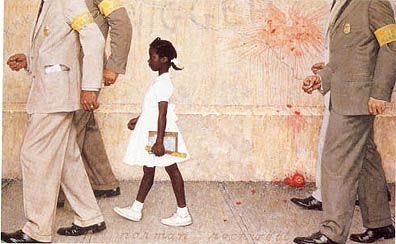Norman Rockwell & The Common Good
In search of visions of who we might become
One of the joys of my gig as a cat caterer and doter of dogs, is that I get a to peruse other people's libraries and I always find something wonderful and unexpected.
A few weeks ago, while being a nearly full time lap for Sadie, I read an autobiography by Norman Rockwell, of Saturday Evening Post Cover fame. Here are some things I learned:
He learned drawing when his father would read novels by Charles Dickens aloud to the family and he would draw the characters in the story.
He studied drawing at the Art Students League in New York and at the time Illustration was considered a serious and important art -- as important as painting.
Although his paintings tend to be optimistic, he personally had a lot of angst and more than one crisis of confidence. He dealt with these crisis as a working artist: he would show up every day to make something, even if he didn't like it. Eventually, through making things, he found his way to making something new that he liked.
A lot of people in the art world did not consider Rockwell an important American painter, and sometimes his paintings were ridiculed as presenting too rosy a picture of American life.No one can deny that his influence on American culture in the 20th century was profound.
He began doing illustrations for the Saturday Evening post in 1916 and continued to do them for the next 47 years. During that time, he used art to reflect the culture but also to take a stance and to offer a vision of what we should strive for.
One of his most famous paintings, The Problem We All Live With was published in Look magazine in 1964. I'm sure you've seen it, but here it is:
Rockwell did not shy away from controversy. This painting is told from the point of Ruby Bridges, the six year old girl who had to be escorted by the national guard to school facing do violent racist protests. The evidence of the violence in this situation is clearly present in his painting. Rockwell did not gloss over the realities in this situation. But in this painting, he also showed us who we might be as a collective and what we should strive for.
In the mid 20th century there was a notion a common good: a shared ethos of equality and an aspiration for justice for all and that being a defining characteristic of being American.
Today as we are in this strange period of coming out of the pandemic, there is much in the world that is in need of a complete overall. I am wondering where we look for visions of who we are and who we might be?
For my part, I wish we had a few more Norman Rockwells.
P.S. If you are interested, check out the Norman Rockwell Museum, here.
And now a reminder from cats and Sister Sledge: We are Family
This week at the Healing Salon: Doodling with Hilma ( and me)
Come doodle, learn a bit about visionary artist Hilma af Klint, and make some art magic. No drawing skill needed. It’s free, it’s fun, it’s one hour. Join me!
To Join, go to https://www.facebook.com/groups/thehealingsalon or Eventbrite:




